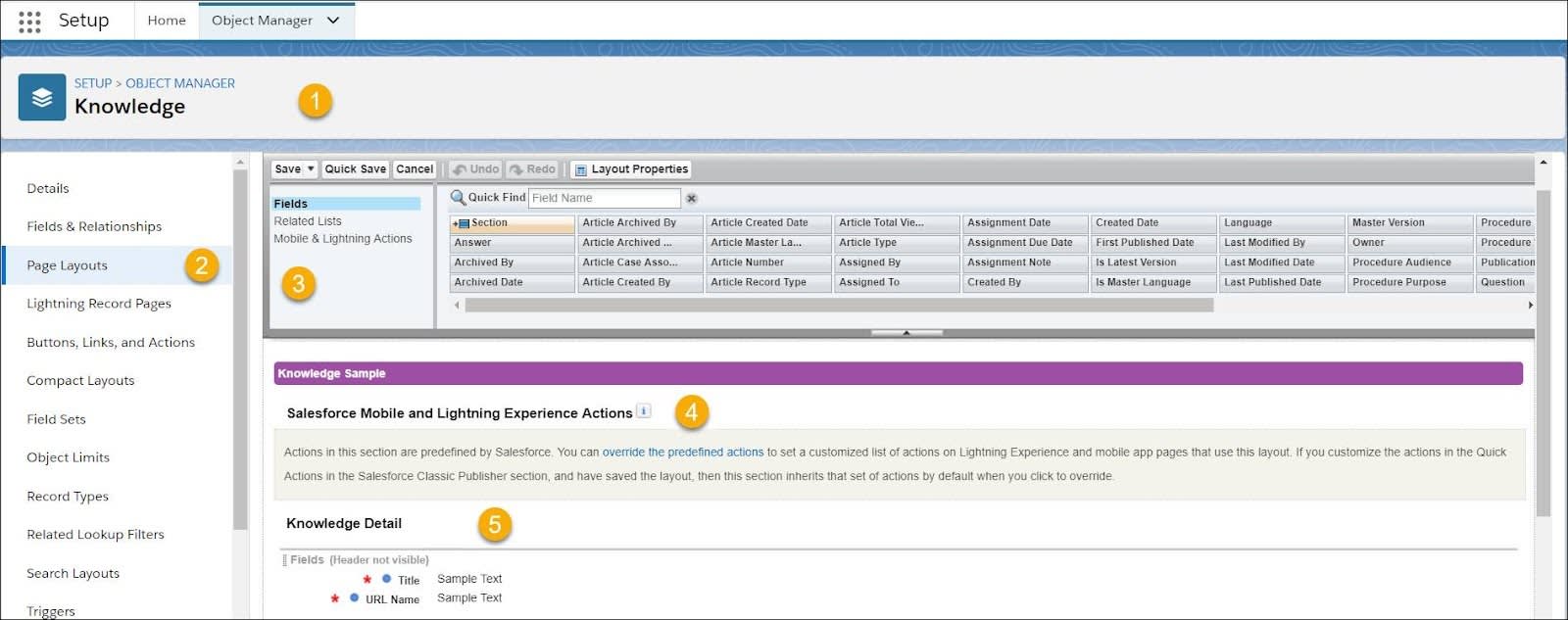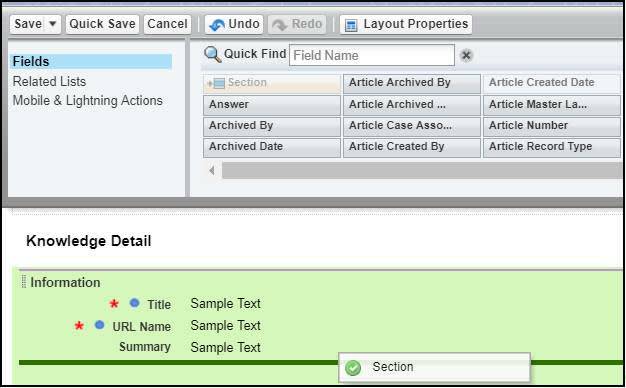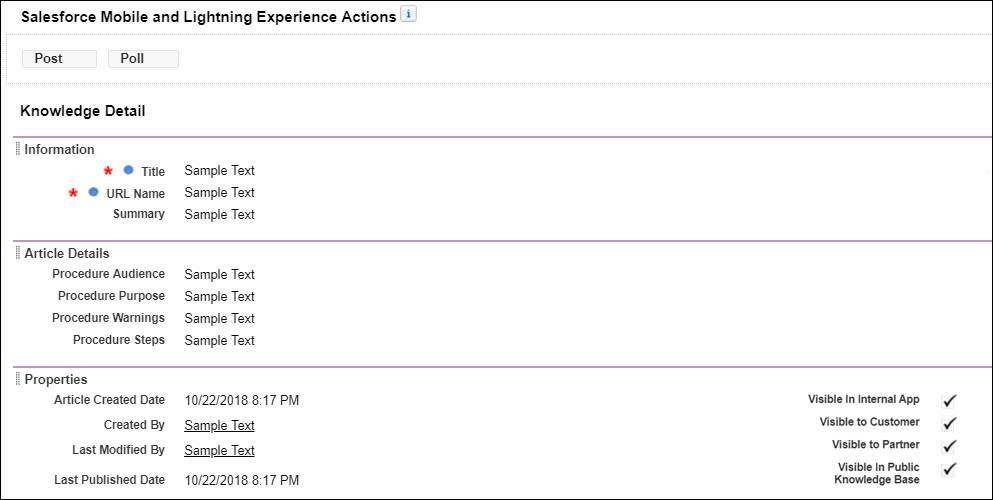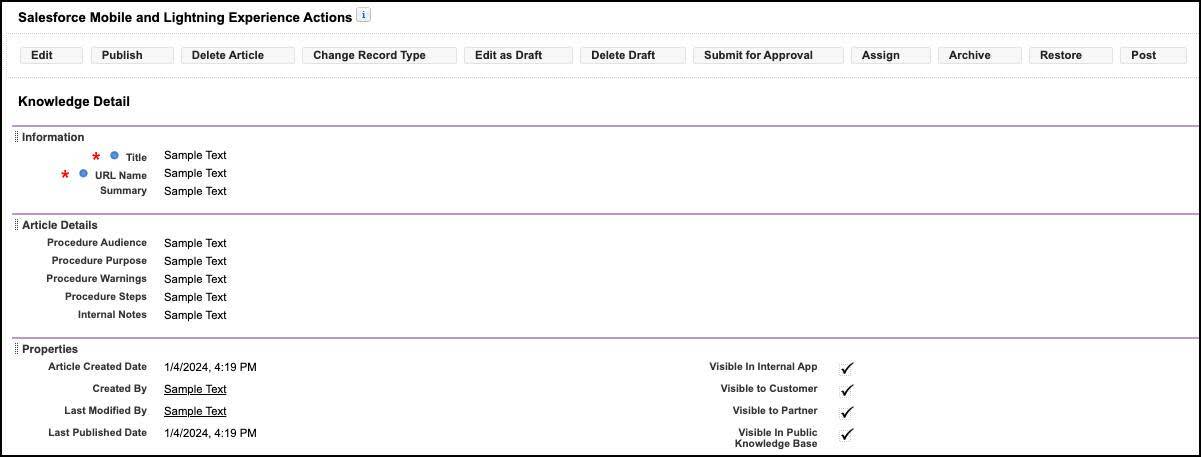Configure Page Layouts and Record Types
Learning Objectives
After completing this unit, you’ll be able to:
- Set up the page layout for a record type.
- Create a record type.
- Use a record type to assign a page layout to a profile.
Create a Page Layout for Readers
Article readers and article authors perform different actions and see different fields on a knowledge article, so Maria must create different page layouts for these users. She creates the page layout for readers first. Let’s follow along and see what she does.
- From Setup
 , choose Setup.
, choose Setup.
- Click Object Manager and select Knowledge.
- Click Page Layouts.
- Click New.
- If you’re basing the page layout on an existing layout, choose it. Maria selects None.
- Enter the name of your page layout. Maria enters
Procedure - Reader.
- Click Save.
The layout editor opens. Let’s take a moment to get acquainted with it.

-
Knowledge object (1)
-
Page Layouts (2)
-
Palette (3)—The palette contains Fields, Related Lists, and Mobile & Lightning Actions that you can add to your page layouts. In this example, Fields is selected, so the palette displays available fields. You can also create custom fields.
-
Salesforce Mobile and Lightning Experience Actions (4)—This section displays actions users can perform on the page. Drag items from the Mobile & Lightning Actions palette to add them to this section.
-
Knowledge Detail (5)—Drag items from the Fields palette to add them to the page layout. In this example, the first section is named Knowledge Details, and it contains Title and URL Name.
Add Actions and Fields
Maria keeps the palette open and consults the list she made with Ada. She’s going to set up the page layout section by section: actions readers can perform, article information, article details, and article properties.
First, she sets up the actions that readers can perform on the article.
- In the palette, click Mobile & Lightning Actions.
- Hover over the Salesforce Mobile and Lightning Experience Actions section.
- Click
 to customize the predefined actions.
to customize the predefined actions.
- Drag Post to the Salesforce Mobile and Lightning Experience Actions section. Post allows users to post to the Article Feed.
- Drag Poll next to Post.
Next, she sets up the Knowledge Detail section. The Title and URL name fields are already there and set as required. She adds one field.
- In the palette, click Fields.
- Drag Summary to the Knowledge Detail section.
Now she creates a section with more information about procedures.
- Drag Section from the palette to below the Knowledge Detail section.

- Name the section. Maria enters
Article Details.
- Leave the defaults checked, then click OK.
- Click Save.
Maria has to create custom fields to finish the Article Details section. She decides to create the other sections first and then come back to the custom fields. Here’s what she does.
- To reopen the editor after saving, click Page Layouts.
- To reopen the page layout, click Procedure - Reader.
- Create a section under Article Details. Maria uses the following values:
- Section Name:
Properties
- Layout: 2-Column
- Tab-key Order: Top-down
- Add the following fields to the first column:
- Article Created Date
- Created by
- Last Modified by
- Last Published Date
- Add the following checkboxes to the second column:
- Visible in Internal App
- Visible to Customer
- Visible to Partner
- Visible in Public Knowledge Base
- Click Save.
Create Custom Fields
Maria has set up everything she can using the fields in the palette. On to creating custom fields for the Article Details section.
The first field she creates is Procedure Audience, a text field for describing an article’s audience.
- From Setup
 , choose Setup.
, choose Setup.
- Click Object Manager and select Knowledge.
- Click Fields & Relationships.
- Click New.
- Choose the field type. Maria chooses Text Area (Rich).
- Click Next.
- Fill out the values. Maria uses these values.
- Field Label:
Procedure Audience
- For Length, # Visible Lines, and Field Name she leaves the default values.
- Description: Use this field to identify who follows or executes this procedure.
- Help text: Who follows this procedure?
- Click Next.
- Establish field-level security. Maria selects Visible for all profiles.
- Click Next.
- Add the field to the palette for the page layout you’re creating. Maria chooses Procedure - Reader. Salesforce adds the new field as the last field in the first section by default. That’s where Maria wants it to go, but she can move it anytime if she changes her mind.
- Click Save.
Maria repeats these steps to create custom fields for Procedure Warnings, Procedure Purpose, and Procedure Steps. She makes sure that the fields are in the correct order in the Article Details section.
Here’s her finished page layout for procedure readers.

Create a Page Layout for Authors
The Procedure - Author and Procedure - Reader page layouts are similar. But the author page has some different actions and an extra field for internal notes. The Internal Notes field is available only to agents who can author articles. Maria creates the Procedure - Author page layout from the existing Procedure - Reader layout.
- From
 , choose Setup.
, choose Setup.
- Click Object Manager and select Knowledge.
- Click Page Layouts.
- Click New.
- If you’re basing the page layout on an existing layout, choose it. Maria selects Procedure - Reader.
- Name the page layout. Maria enters
Procedure - Author.
- Click Save.
Maria changes the actions. Instead of Poll and Post actions, Maria includes: Edit, Publish, Delete Article, Change Record Type, Edit as Draft, Delete Draft, Submit for Approval, Assign, Archive, Restore, and Post.
She creates a custom field for Internal Notes using the following values.
- Data type: Text Area (Rich)
- Field Label:
Internal Notes
- Field-level security: Custom: Support Profile. Maria created this profile for Ursa Major when she set up the knowledge base.
- Page layout: Procedure - Author. This adds the field to the Procedure - Author page layout at the bottom of the first new section. Maria makes a note to ask Ada later if she should add this field to the FAQ - Author page, too.
Here’s what Maria’s page layout for Procedure - Author looks like with the new fields.

Create and Assign a Record Type for Procedures
Maria has created two different page layouts—one for readers and one for authors. Now she creates a record type to show the correct page layout to the correct users. How does she know which users are which? By their profiles. Customers see the Procedure - Reader page layout. Agents see the Procedure - Author page layout.
Here’s how Maria creates and assigns the Procedure record type.
- From
 , choose Setup.
, choose Setup.
- Click Object Manager and select Knowledge.
- Click Record Types.
- Click New.
- Select an existing record type to use as a template. The new record type includes the picklist values of the selected record type. Maria chooses Master.
- Enter a label for your record type. Maria enters
Procedure.
- Enter a description. Maria enters
For step-by-step instructions.
- Select Active to make this record type available immediately.
- Select the profile that will use this record type. Maria selects Make Available next to the Customer profiles listed.
- Click Next.
- Select the page layout that users with these profiles see for this record type. Maria chooses Procedure - Reader.
- Click Save.
All users assigned the Customer profiles see the Procedure - Reader page layout. They can view articles, but they can’t edit them.
Next, Maria assigns the Procedure - Author page layout to agents using the regular profile user interface. Agents can edit articles.
- From
 , choose Setup.
, choose Setup.
- Enter
Profilesin the Quick Find box, then select Profiles.
- Select a profile. Maria chooses Custom: Support Profile, a profile she created earlier.
- Scroll down to Custom Record Type Settings and click Edit.
- Move the needed record types from the Available Record Type box to the Selected Record Types box. Maria adds FAQ and Procedure.
- Choose a default record type. Maria chooses FAQ.
- Click Save.
Maria’s configured a new type of article, procedures, in Ursa Major’s knowledge base. To do it, she created different page layouts and assigned them to the correct users via record types. It’s time for Ada to start creating the procedures.
In addition to page layouts, you can also add and customize components on record pages. Maria doesn’t need that level of customization, but you might. To learn more, check out the Lightning App Builder module.
Resources
-
Salesforce Help: Create Custom Fields
-
Salesforce Help: Page Layout Considerations for Lightning Knowledge
-
Salesforce Help: Record Type Considerations for Lightning Knowledge
-
Salesforce Help: Create and Edit Articles
-
Trailhead: Lightning App Builder
-
Salesforce Help: Assign Record Types and Page Layouts in the Enhanced Profile User Interface